Leiden er vinalegur háskólabær í Suður-Hollandi í Niðurlöndum, í um 50 km aksturfjarlægð frá Amsterdam. Þar búa meira en 120 þúsund manns. Bærinn státar af ríkri menningarsögu og þar er elsti háskólinn í Hollandi, stofnaður árið 1575. Stjörnufræði í Leiden byggir á langri hefð. Árið 1633 var stjörnustöð reist við háskólann til þess að skýla og varðveita kvaðrant hollenska stjörnufræðingsins Willebrord Snelliusar (1580-1626). Hann reyndi m.a. að ákvarða ummál jarðar, með umfangsmiklum þríhyrningamælingum, og við hann er ljósbrotslögmálið kennt, lögmál Snells. Stjörnustöðin í Leiden er elsta háskólastjörnustöð í heiminum sem enn er uppistandandi (Mynd 1).
Leiden is a friendly university town in South Holland, the Netherlands, about 50 km driving distance from Amsterdam. More than 120 thousand people live there. The town boasts a rich cultural history and is home to the oldest university in the Netherlands, founded in 1575. Astronomy is based on a long tradition in Leiden. In 1633, an observatory was built at the university to shelter and preserve the quadrant of the Dutch astronomer Willebrord Snellius (1580-1626). He tried, among other things to determine the circumference of the earth, by extensive triangulation, and the law of refraction is named after him, Snell’s law. The Leiden Observatory is the oldest remaining university observatory in the world (Figure 1).
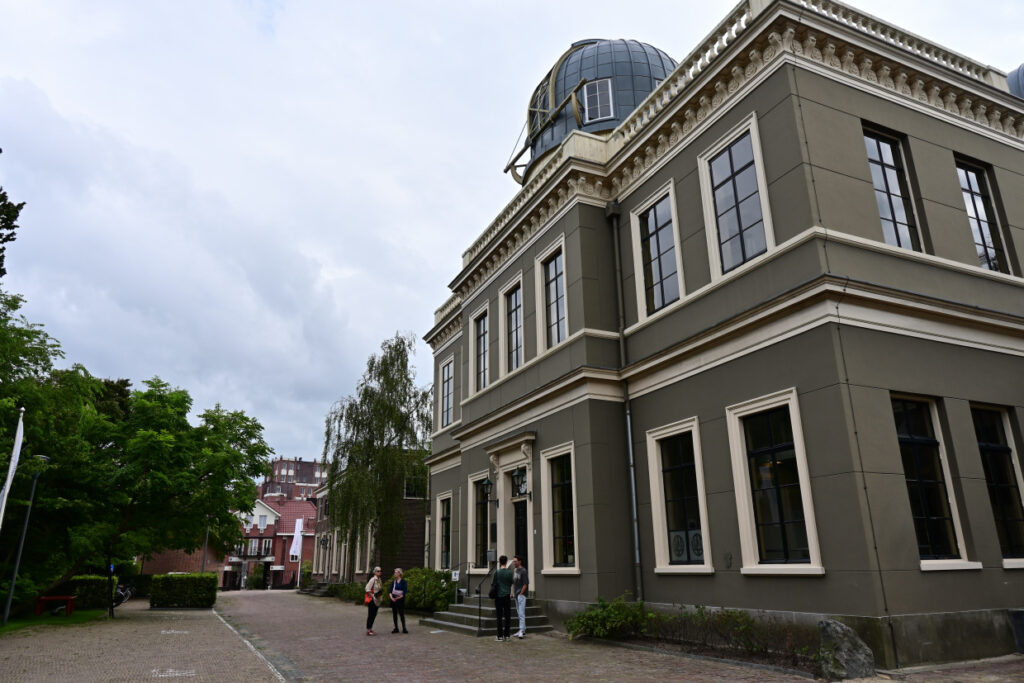
Mynd/Fig. 1. Gamla stjörnustöðin í Leiden — The old Observatory in Leiden.
Næstu tvær aldirnar var stjörnustöðin mest notuð í kennslu en síðan endurbyggð og stækkuð árið 1861. Endurbyggingin markar byrjun mikillar uppsveiflu í stjörnufræði í Niðurlöndum. Á fyrri hluta 20. aldar varð Leiden heimsklassa vísindamiðstöð þar sem frægir eðlisfræðingar og Nóbelsverðlaunahafar störfuðu. Á sögusíðu Leiden stjörnustöðvarinnar eru m.a taldir upp Willem de Sitter (1872-1934), Albert Einstein (1897-1955), Ejnar Hertzsprung (1873-1967) og hollenski stjarneðlisfræðingurinn Jan Oort (1900-1992), sem var einn frægasti stjörnufræðingurinn sem starfaði í Leiden.
The observatory was primarily used for teaching for two centuries before it was rebuilt and enlarged in 1861. The reconstruction signifies the beginning of an new era in astronomy in the Netherlands. Leiden became a world-class science centre during the first part of the twentieth century, with notable physicists and Nobel laureates working here. The Leiden Observatory’s history page mentions the notable Willem de Sitter (1872-1934), Albert Einstein (1897-1955), Ejnar Hertzsprung (1873-1967), and the Dutch astrophysicist Jan Oort (1900-1992), who was one of the most prominent astronomers to work in Leiden.
Á 20. öld úreltust stjörnustöðvar í borgarlandi fyrir nútíma stjörnuathuganir. Frá seinni hluta 20. aldar hafa stjörnufræðingarnir, og þar með vísindastofnun Leiden stjörnustöðvarinnar flutt sig um set og rekur stjörnustöð í Suður-Afríku. Evrópska suðurstjörnustöðin (ESO) var stofnuð árið 1962. Hún er á meðal mikilvægustu stjörnustöðva heims, með Very Large Telescope (VLT) og hlut í Atacama Large Millimeter Array (ALMA). Á árunum 2008-2012 var gamla stjörnustöðin hins vegar gerð upp til að viðhalda og kynna almenningi hina merku sögu stofnunarinnar (Myndir 2a-b).
In the 20th century, urban observatories became obsolete for modern astronomy. In the second half of the 20th century, the scientific institute of the Leiden Observatory relocated and operated an observatory in South Africa. The European Southern Observatory (ESO) was founded in 1962. It ranks as one of the most important observatories in the world, with the Very Large Telescope (VLT) and part of the Atacama Large Millimetre Array (ALMA). However, the old observatory building was restored in 2008–2012 to maintain the significant institution and exhibit its history to the public (Figures 2a–b).
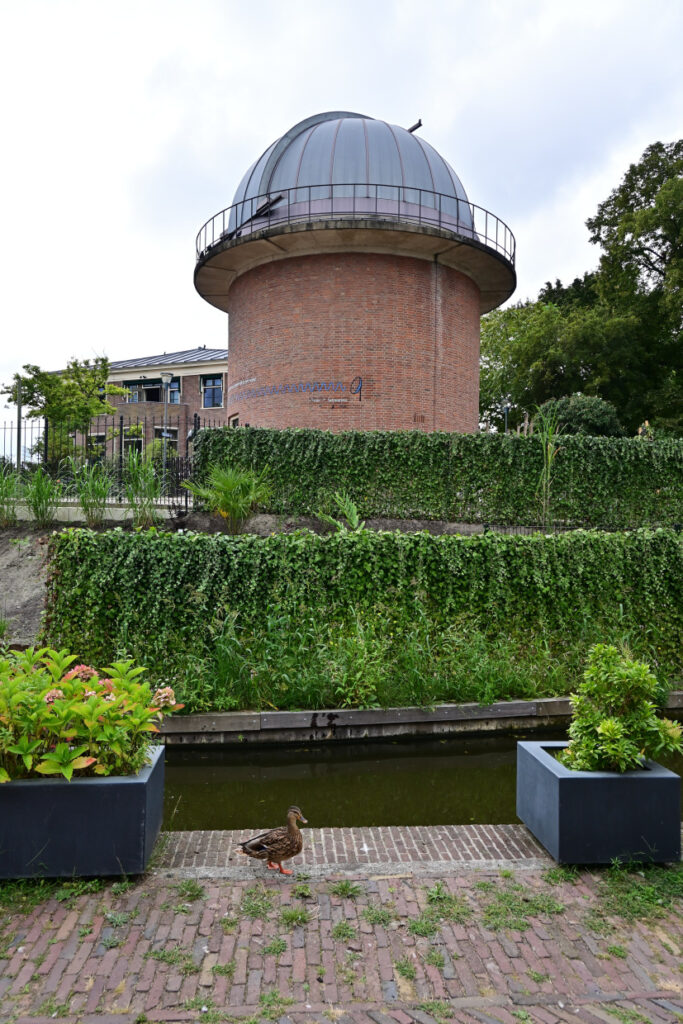
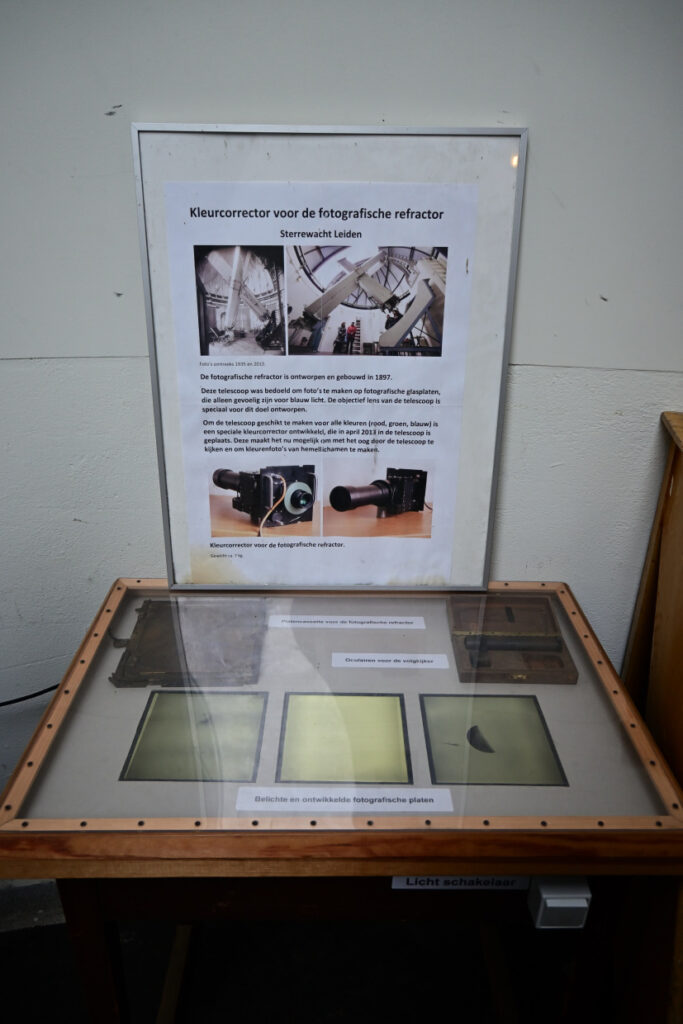
Mynd/Fig. 2a-b. a) Einn stjörnuturnanna í Leiden, sá sem hýsir stjörnuvíðsjána. b) Ljósmyndaplötur til sýnis um gamla tækni. — a) The observatory dome, which houses the astrograph. b) photographic plates that now represent the old technology.
Þann 4. september 2024 heimsóttum við gömlu stjörnustöðina en í boði var almenn kynnisferð um sögu byggingarinnar, starfseminnar og sjónaukanna. Þó flestöll tæki séu nú komin á safn hýsa stjörnuturnarnir enn fjóra sögulega sjónauka. Einn þeirra, gamla stjarnvíðsjáin, sem er staðsett í einum stjörnuturnanna, var kynntur fyrir gestum. Stjarnvíðsjáin er 524 cm langur linsusjónauki og er þvermáli ljósopsins 33 cm. Hann var settur upp árið 1897 og er enn sá stærsti í Niðurlöndum. Víðsjáin var hönnuð fyrir ljósmyndatöku en í lok 19. aldar var það byltingarkennd ný tækni til stjarnfræðirannsókna. Lengst af var notast við glerplötur sem voru þaktar ljósnæmri silfurhalíð-blöndu í myndatökur. Tækin eru auðvitað ekki lengur notuð nema til sögukynningar og kennslu.
On September 4, 2024, we attended a public tour around the old observatory, to learn about the building’s history, its operation, and the telescopes. Four historical telescopes still remains in the observatory, but other instruments have been placed in a museum. The ‘ photographic double refractor‘ is installed in one of the observatory domes’. Its length is 524 cm, and its aperture measures 33 cm. This is the largest refractor in the Netherlands. The refractor was installed in 1897, and was made for photography, which was a new revolutionary technology for astronomical research around the end of the 19th century. Glass plates coated in a light-sensitive silver halide emulsion were typically used for photography. The instruments are no longer used except in historical presentation for the public and teaching.
Fyrir þá sem eru áhugasamir um sögu stjörnu- og eðlisfræði er heimsókn til Leiden, og gömlu stjörnustöðina svo sannarlega þess virði.
For those who are interested in the history of astronomy and physics, a visit to Leiden and the historic observatory is highly recommended.
Byggt á/Based on “Old observatory of Leiden – History“.
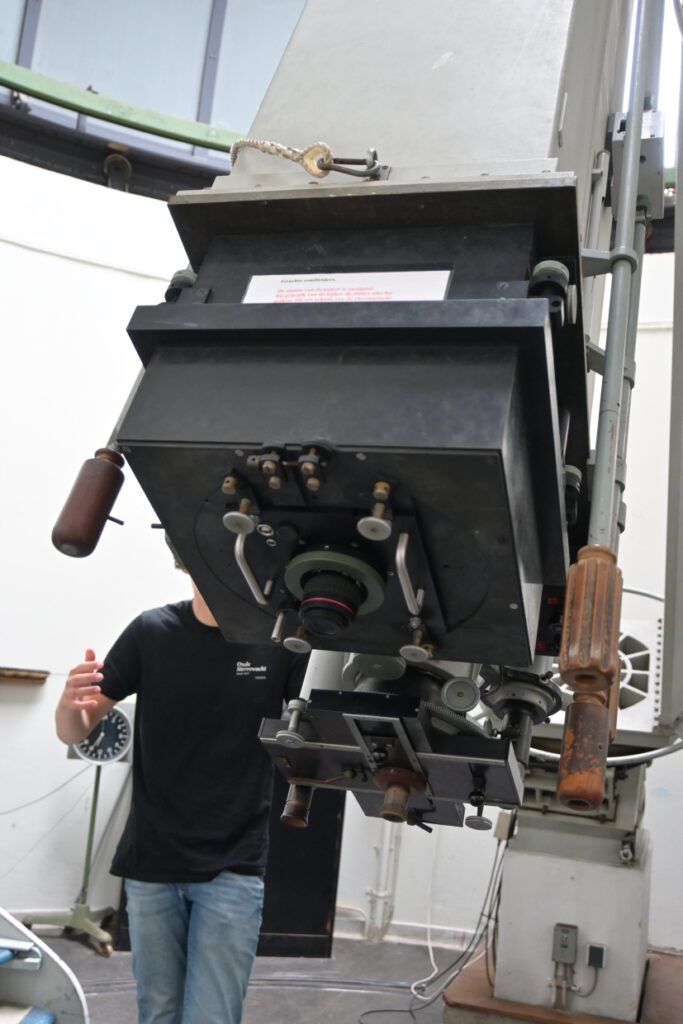
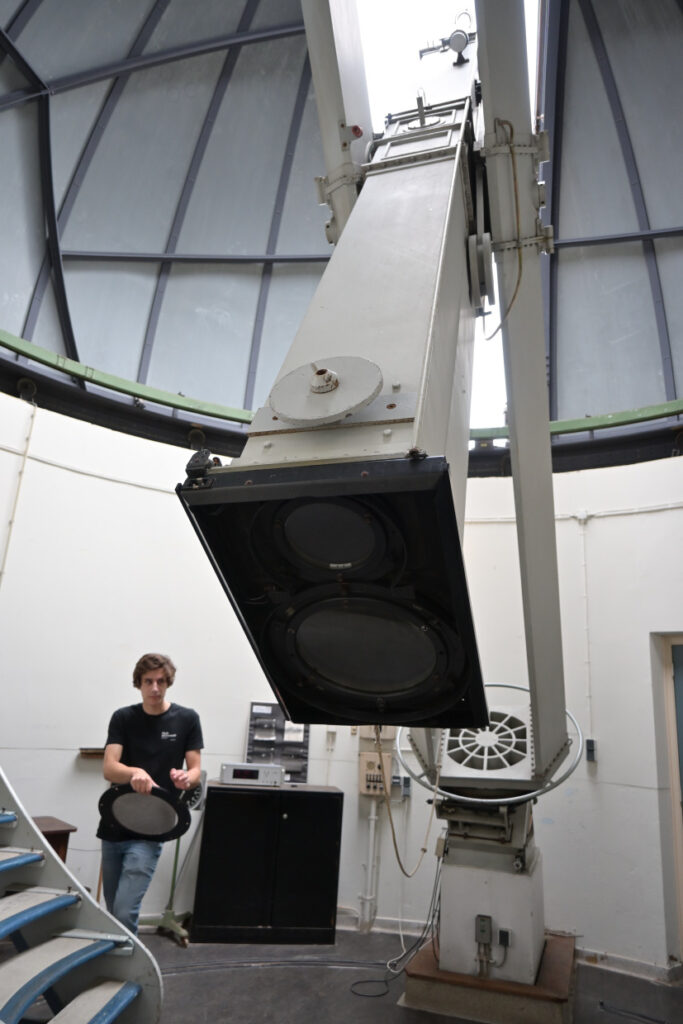
Mynd/Fig. 3a-b. a) Ljósmyndabúnaðurinn sem er áfastur enda sjónaukans. b) Stjarnvíðsjáin í stjörnuturninum.— a) The photographic device installed to the refractor. b) The old ‘photographic double refractor’ under the observatory dome.
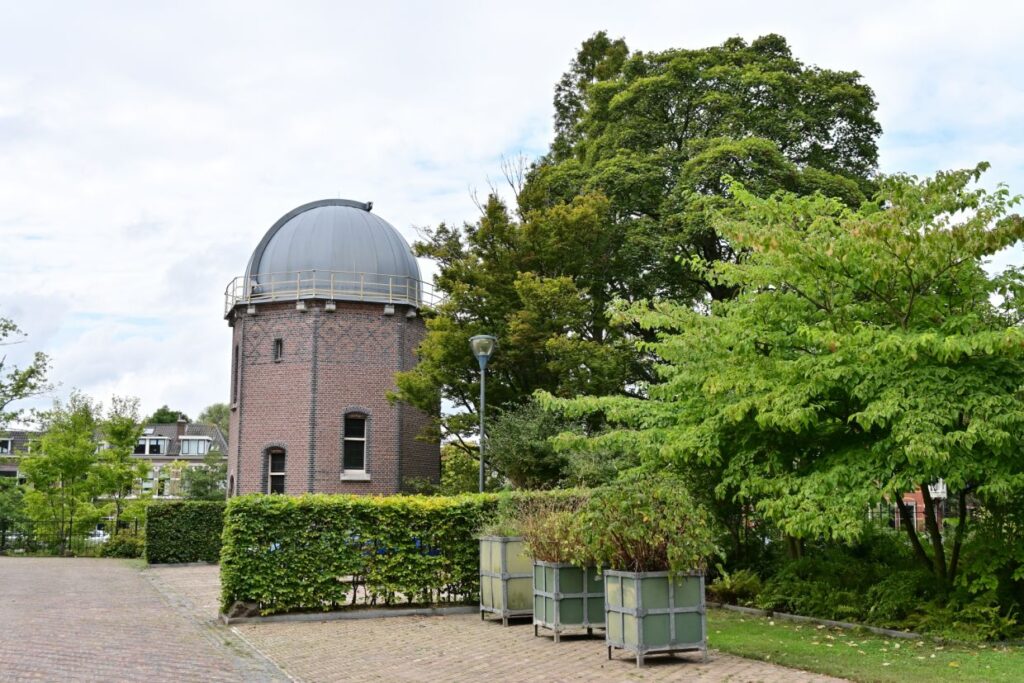
Mynd/Fig. 4. Einn stjörnuturnanna í Leiden.— One of the observatory dome in Leiden.
Tilvitnun í grein:
Snævarr Guðmundsson 2024. Leiden stjörnustöðin. Rafræn grein. Vefslóð: https://natturumyndir.is/.